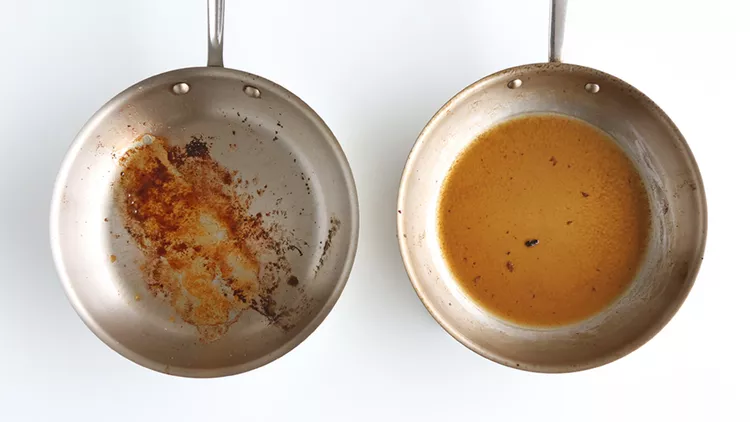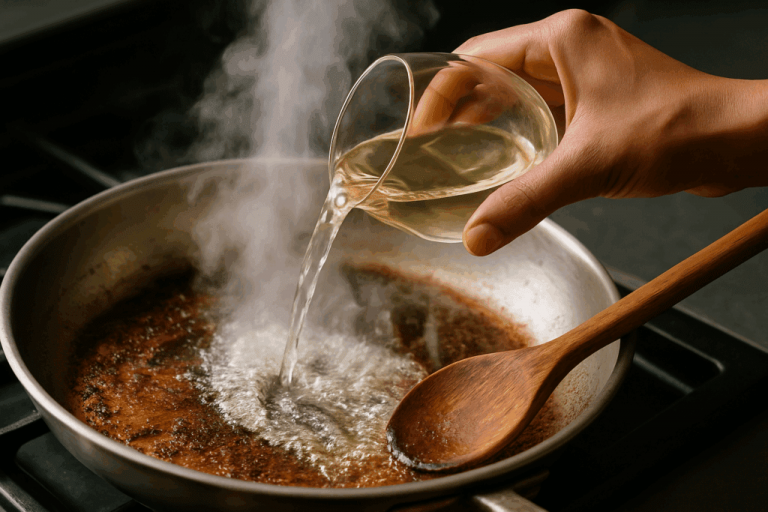Deglazing, a classic French cooking technique, is one of the best ways to make a flavourful sauce or gravy to accompany a dish. Learn how to deglaze and take your dish from average to amazing.
Deglazing 101
Simply put, deglazing is the process of pouring a liquid into the pan where meat has been seared or veggies have been caramelised. While you get colour on these ingredients, some bits get stuck and left behind on the pan itself (called the fond). These bits are actually the most flavourful, and in order to dislodge them, chefs pour a liquid straight into the hot pan. The heat from the pan almost instantly boils the liquid, loosening the seared bits in the process.
Depending on the dish, use a small amount of liquid to help dislodge those tasty food bits, and let it evaporate before moving on to the next step. Alternatively, if you’re looking to make a sauce or gravy, use more liquid and evaporate until slightly thickened.
Traditionally, deglazing accompanies searing meats or caramelising onions. But it doesn’t have to stop there. Deglazing is also used for stews, soups, curries, and even certain desserts (like making a rum-infused butterscotch sauce).
How to deglaze: Step-by-step

Once you’ve seared meats, caramelised sugar or onions, and bloomed spices, remove larger foods (like meats and chunky veggies) before starting the deglazing process.
1. Add the liquid
Keep the heat on medium-high to instantly heat the liquid. Slowly pour in the liquid of choice and watch as it bubbles and steams as it heats up.
2. Bring the liquid to a simmer
Leave the liquid to do its magic in the pan, allowing it to come to a simmer (not a boil). This gentle simmering helps to activate the gentle release of the fond.
3. Scrape, scrape, scrape!
Using a wooden or silicone spoon, gently scrape the fond from the bottom of the pan. You want a sturdy tool that doesn’t damage your pan. Keep scraping until the bottom looks clear again, paying special attention to the sides (where there might be sufficient buildup).
4. Simmer away
Let the liquid simmer for a few more minutes until either any alcohol has evaporated or the required saucy consistency has been reached. Don’t panic if you think you’ve let it go too far. You can always add another splash or two of liquid and simmer again until you’re pleased with the consistency.
What liquids can I use?
Alcohol
While the liquid simmers, the alcohol evaporates, leaving behind a mild, sometimes slightly sweet flavour.
- Wine: Most commonly used because it usually has a good balance of sweetness and acidity without being overpowering. Use white wines and rosés for light meats, veggies, and grains, and red wines for darker meats, earthier veggies and grains.
- Beer: Lighter beers like pale ales contribute a light, yeasty flavour, while darker beers like a stout are bold enough for darker meats.
- Vermouth, Vodka, and Gin: Use these clear liquors for lighter dishes, like tomato pastas or chicken dishes needing a good kick.
- Brandy, Rum, Whiskey: Use these darker liquors for more robust, even sweet, dishes like beef pie fillings or butterscotch sauces.
Broth and stock
Broths and stocks are usually used as the base of a tasty sauce or gravy, and so make for a great deglazing base too. Pair chicken, beef, lamb, pork, vegetable, or seafood broths and stocks accordingly. Broths and stocks shouldn’t be used in sweet dishes.
Fruit or vegetable juices
Citrus juice is most often used as its acidity helps release the fond and adds a great punch to the overall dish. You can play around with other juices like tomato, carrot and apple to complement your dish.
Water
You can never go wrong with plain old water. Its neutral flavour decreases the risk of unbalancing your dish with out-there flavours, doesn’t contain any sugars that could potentially catch and burn, works for both sweet and savoury dishes, and is readily available. It’s important to note that when using water, you must use it sparingly (you can always add more) so as not to overly dilute your dish.
Deglazing isn’t reserved as a fancy word that only the most accomplished chefs use. It’s an important technique in cooking that can enhance your dish tenfold. With the right liquid and some good old scraping, you’ll be cooking dishes like the pros in no time!

